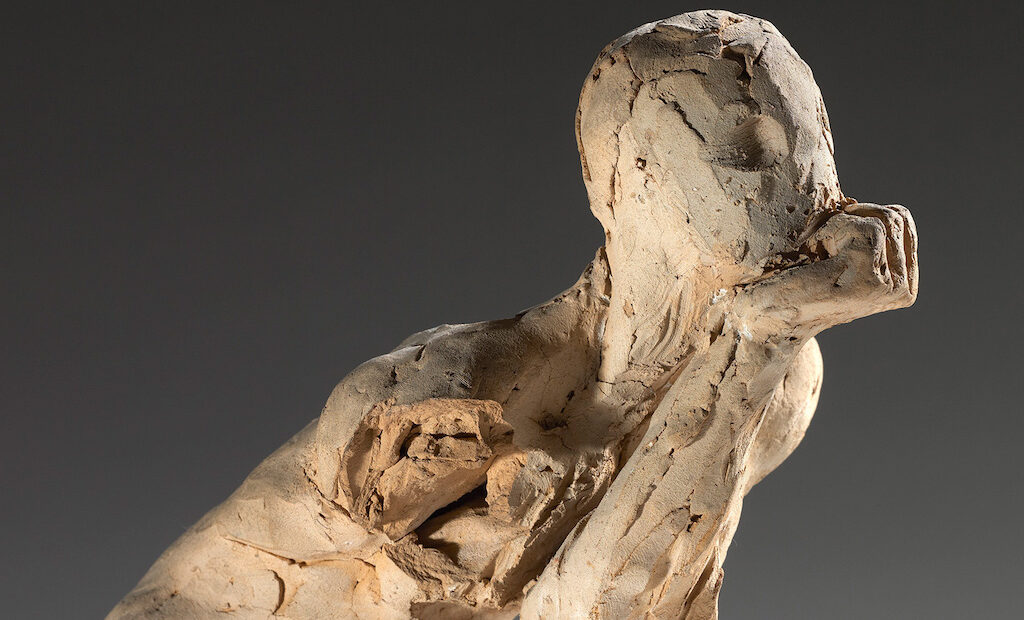The Making of Rodin at Tate Modern

For a sculptor who would bestride the end of the 19th and beginning of the 20th centuries like a bearded colossus, Auguste Rodin had a slow burner of an artistic career in his formative years. Born into relative poverty in 1840, he failed the entrance exam for the Ecole des Beaux-Arts three times, gaining experience as a workshop assistant. It was his male nude, The Age of Bronze, that finally grabbed the attention at the Paris Salon in 1877. Such was the realism achieved that it prompted accusations of him directly casting from his model – a Belgian soldier called Auguste Neyt. To prove doubters wrong, the artist had photographs taken of the sitter and work, emphasising differences. The offshoot was that Rodin moved away from the classical, idealised portrayal of the human body.
In 1900, the 60 year-old Rodin gambled on investing everything he had into the building of a temporary pavilion to show his work, near the Paris Universal Exposition of that year. He took the unusual step of only displaying plaster casts. It is this exhibition at the Pavillon de l’Alma in Paris that provides the impetus for the new Tate Modern exhibition, The Making of Rodin.
The sculptor intended to engender a sense of viewers having been invited into his studio. In 1900, casts were commonly considered a transitional stage between clay modelling and bronzes. The Tate have imitated the layout of the original Paris exhibition in their central room. Plaster casts dominate this show, apart from the opening, where one finds the spectacular bronze figure The Age of Bronze (1875-76) and a Tate-owned marble of his celebrated The Kiss (1901-04).
A cast of The Thinker sits, mighty and brooding, with a lone duplicate of his oversized foot (Rodin fell under the spell of Michelangelo during an 1875 trip to Italy), placed on a plinth of its own. He presents the latter like an archaic relic. One soon becomes aware that curators are proposing that Rodin’s liking for repetition, fragmentation and appropriation of artefacts make him a precursor to Duchamp and Warhol.
This call for the Frenchman to be reconfigured as a modernist is questionable. Tate Modern’s 200 works demonstrate his innovation. However, the implication of his ushering in the modern era of the mass production of “multiples” is simply diverging from reality: the 19th century saw reduced facsimiles of famous works become available to all. In the exhibition of 1900, Rodin projected the myth of himself as a solitary genius. In truth, he used his hands to transform clay into form, employing experts to transpose them to other materials. A huge cast head of a character from the Burghers of Calais at the Tate testifies to how skilled assistants like Henri Lebossé utilised a pantograph to make enlargements or reductions of models.
In 1880 the French government commissioned Rodin to create the entrance for an ultimately never built Museum of Decorative Arts. The Gates of Hell became a repertory of images, Dante’s Inferno originally providing the iconographic stimulus. The Thinker was conceived as a portrait of Dante to sit above the two leaves of the Gates, symbolising human creativity. In the final room here, The Three Shades challenges the conventions of sculpture as a unique subject with the casting of three figures, each portraying Adam. They were intended for the summit of The Gates of Hell. Rodin accumulated a rather macabre collection of plaster limbs – displayed in a cabinet in this exhibition – he called giblets, that could be attached to other models.
Studies for the Honoré de Balzac monument offer real highlights. Models reveal the artist capturing the literary great’s pot-bellied, squat frame, naked and without a head. Dynamic busts of the Tours cart driver chosen as a substitute for long-dead Balzac feature, along with a surreal, drenched-in-plaster dressing gown. The relaxed attire favoured by the writer would provide a striking unity of form. A plaster version of the final monument of 1898 gives Balzac a megalithic presence, eschewing the realism of conventional portraiture. The bronze was rejected on its unveiling.
In another room mainly devoted to Rodin’s frequently erotic drawings and watercolours of female models, organisers have been at pains to articulate that the artist’s relationships with them were “starkly unequal”, with him failing to “personalise their nude bodies”. Further focus is accorded to collaborators and models: two casts of Camille Claudel’s head feature (the gifted sculptor who became a studio assistant, collaborator and the artist’s lover); opposite, one finds masks he made of the Japanese actor and dancer Hanako, holding her facial features in the agonised expression she adopted for her dramatic interpretation of hara-kiri.
Rodin avidly collected Ancient Greek, Roman, Egyptian and Far Eastern artworks. From 1895 he is shown to be “appropriating” some of the terracotta artefacts, combining them with plaster figures. His 1895-1910 assemblage Female Torso with the Head of Slavic Woman features a plaster sylph, eyes downcast, contained almost entirely within a black Etruscan vessel.
Auguste Rodin brought a new expressive realism to figurative sculpture. Beauty courses through the veins of this exhibition, and the artist’s creative processes are brought sharply into focus; the plasters are discoloured, graphite marks and the fusion of components visible. Works like The Burghers of Calais (1889), the restored cast of which stands illuminated by Tate Modern’s windows, its figures a twisting mass of raw emotion, speak of Rodin’s ability to convey how the body feels in every nerve and sinew.
James White
The Making of Rodin is at Tate Modern from 18th May until 21st November 2021. For further information visit the exhibition’s website here.
























Facebook
Twitter
Instagram
YouTube
RSS